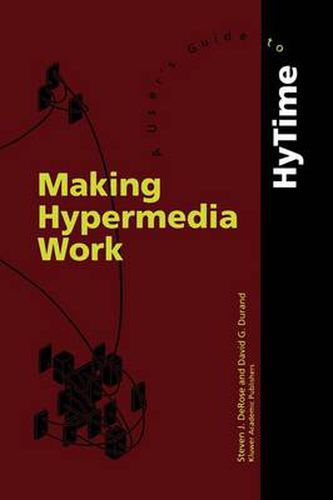Readings Newsletter
Become a Readings Member to make your shopping experience even easier.
Sign in or sign up for free!
You’re not far away from qualifying for FREE standard shipping within Australia
You’ve qualified for FREE standard shipping within Australia
The cart is loading…






This title is printed to order. This book may have been self-published. If so, we cannot guarantee the quality of the content. In the main most books will have gone through the editing process however some may not. We therefore suggest that you be aware of this before ordering this book. If in doubt check either the author or publisher’s details as we are unable to accept any returns unless they are faulty. Please contact us if you have any questions.
This work discusses how the HyTime standard can be applied to real world problems of moving from here to there in collections of documents. The HyTime standard itself provides methods and templates for various information structures such as links, and various kinds of location indicators. A HyTime application specifies how a group applies those templates to their particular requirements. This involves choosing which HyTime structures are needed, setting up conventions for how they are to be used and setting up management and processes for creation, conversion and updating of hypermedia documents. A HyTime engine is the last ingredient: actually using an application typically involves choosing software to support one’s use of HyTime and customizing it as needed. This may be as simple as setting up hypertextual style sheets that determine how links and other things look and act. More specialized applications may require full-scale design and programming. This text is an in-depth guide to HyTime specifications, both describing its key features and providing guidelines on how it is used. The book begins by detailing the HyTime constructs and models used to identify, locate, and link data. It goes on to introduce some of HyTime’s mechanisms for linking multidimensional, multimedia data, and for scheduling it in space and time. The authors help the reader become fluent in HyTime as it applies to the simpler and most widely understood data types. After mastering this level of HyTime, readers should be ready and able to explore the potential of HyTime for more sophisticated multimedia applications.
$9.00 standard shipping within Australia
FREE standard shipping within Australia for orders over $100.00
Express & International shipping calculated at checkout
This title is printed to order. This book may have been self-published. If so, we cannot guarantee the quality of the content. In the main most books will have gone through the editing process however some may not. We therefore suggest that you be aware of this before ordering this book. If in doubt check either the author or publisher’s details as we are unable to accept any returns unless they are faulty. Please contact us if you have any questions.
This work discusses how the HyTime standard can be applied to real world problems of moving from here to there in collections of documents. The HyTime standard itself provides methods and templates for various information structures such as links, and various kinds of location indicators. A HyTime application specifies how a group applies those templates to their particular requirements. This involves choosing which HyTime structures are needed, setting up conventions for how they are to be used and setting up management and processes for creation, conversion and updating of hypermedia documents. A HyTime engine is the last ingredient: actually using an application typically involves choosing software to support one’s use of HyTime and customizing it as needed. This may be as simple as setting up hypertextual style sheets that determine how links and other things look and act. More specialized applications may require full-scale design and programming. This text is an in-depth guide to HyTime specifications, both describing its key features and providing guidelines on how it is used. The book begins by detailing the HyTime constructs and models used to identify, locate, and link data. It goes on to introduce some of HyTime’s mechanisms for linking multidimensional, multimedia data, and for scheduling it in space and time. The authors help the reader become fluent in HyTime as it applies to the simpler and most widely understood data types. After mastering this level of HyTime, readers should be ready and able to explore the potential of HyTime for more sophisticated multimedia applications.